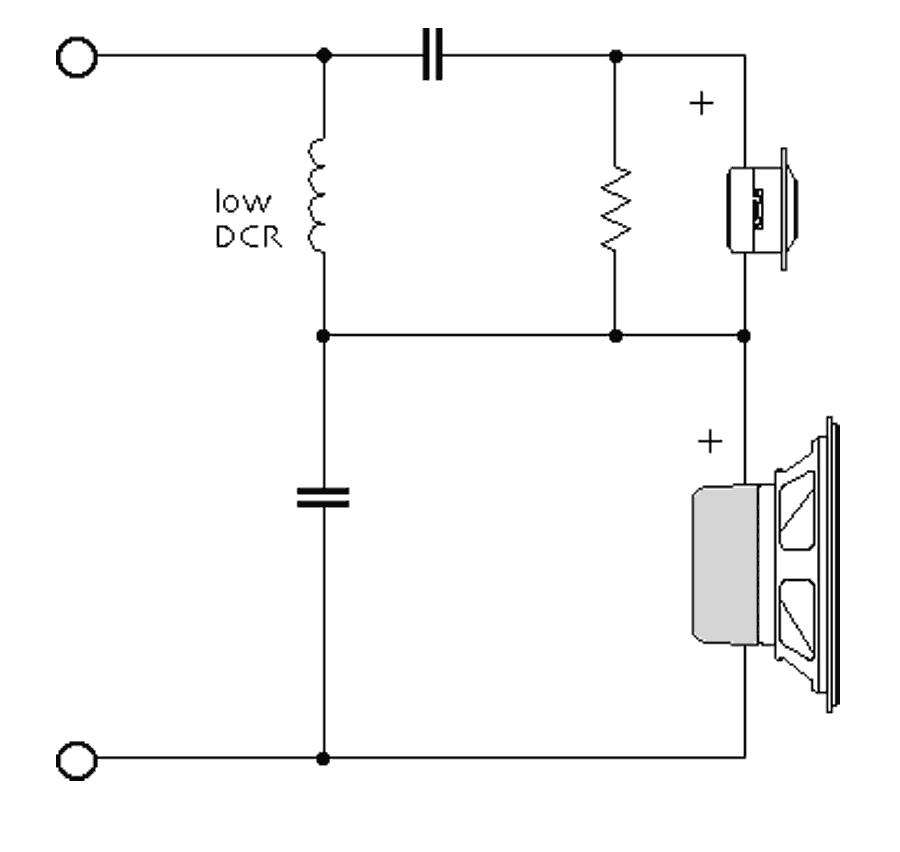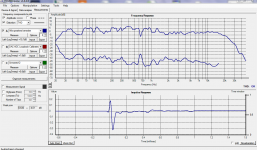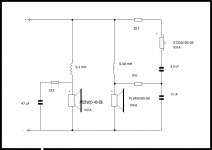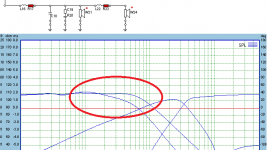Hi Guys,
This is my first post here.
Recently I came across a very interesting crossover design for 2.5 network, which has positive feedback:

It was apparently evolved from this 2 way network:

My question is, what order is this?
It appears to me third order in HP, and 2nd order in LP.
What is the FC assume all drivers are 8ohm?
Cheers,
This is my first post here.
Recently I came across a very interesting crossover design for 2.5 network, which has positive feedback:

It was apparently evolved from this 2 way network:

My question is, what order is this?
It appears to me third order in HP, and 2nd order in LP.
What is the FC assume all drivers are 8ohm?
Cheers,
The 0.5 is not really a xover, rather a trick.
The 3.3 mh / 4.7mh coil on the woofer does not really makes for a low pass filter, it simply has a shelving effect that attenuates the mid range of the woofer and avoids phase interaction with the midwoofer.
For a proper xover you need to cross both channels, if you don't the result is an accident in the sum due to incorrect phase relation between ways.
Obviously, the mid/tweeter part of this set up has no xover, a 0.5 woofer affair is added/sticked in parallel to the 2ways series filtered mid/tweeter part.
Does it work? Yes, sure: Half works!😉
The 3.3 mh / 4.7mh coil on the woofer does not really makes for a low pass filter, it simply has a shelving effect that attenuates the mid range of the woofer and avoids phase interaction with the midwoofer.
For a proper xover you need to cross both channels, if you don't the result is an accident in the sum due to incorrect phase relation between ways.
Obviously, the mid/tweeter part of this set up has no xover, a 0.5 woofer affair is added/sticked in parallel to the 2ways series filtered mid/tweeter part.
Does it work? Yes, sure: Half works!😉
Last edited:
That .5 is there to compensate for the baffle step. The .5 woofer does double the SPL where it drops off due to the baffle step. This is not a more-or-less construction. It is a correct construction - except one detail: The .5 should be a first order lowpass but given that the woofer isn't a resistive load there schould be an RC series network parallel to the .5 woofer which helps to compensate for the effect of its inductance. Without it the lowpass is not really a lowpass but a lag filter.
The rest is indeed a series crossover with 3rd order HP and 2nd order LP.
Regards
Charles
The rest is indeed a series crossover with 3rd order HP and 2nd order LP.
Regards
Charles
Last edited:
That .5 is there to compensate for the baffle step. The .5 woofer does double the SPL where it drops off due to the baffle step. This is not a more-or-less construction. It is a correct construction - except one detail: The .5 should be a first order lowpass but given that the woofer isn't a resistive load there schould be an RC series network parallel to the .5 woofer which helps to compensate for the effect of its inductance. Without it the lowpass is not really a lowpass but a lag filter.
The rest is indeed a series crossover with 3rd order HP and 2nd order LP.
Regards
Charles
Sure but the baffle step is not a first order either, simply another shelf, and the woofer itself is also affected by baffle step, though this is partly compensated by floor proximity.
What 0.5 does is no xover, but rather shelves ovelapping to try avoiding phase anomallies. It might be a nice trick, but not really a seroius design.
Of course supposing that the woofer inductance allows some effect to the coil. With a real woofer or a bad high inductance midwoofer it will do practically nothing. And yes you might add a zobel, but this is beginning to look like designing stuff, not simply making tricks....
Btw, this sort of set up usually is based on using the same midwoofer.
Last edited:
The only effect of a larger voice coil inductance is that you need to make your 0.5way inductor even bigger.With a real woofer or a bad high inductance midwoofer it will do practically nothing.
If you don't believe that a single inductor can make a low pass then look at this design:
http://www.zaphaudio.com/ZDT3.5-crossover.gif
http://www.zaphaudio.com/ZDT3.5-transferfunction.gif
The 0.5 woofer is clearly rolling off at a rate which is 6dB/octave steeper.
The explanation is as such:
It is phase linear in the x-over region.
It allows perfect pulse reproduction from Bass / Midrange frequencies..
It performs a firm and fast bass response, that 24dB filters come short of.
It's cheap and easy to build.
It plays Music!.
The filter has already been tested with a number of different units, and tests show that you may have to adjust the treble series resistor to fit its sensitivity to the bass/midrange unit.
It is phase linear in the x-over region.
It allows perfect pulse reproduction from Bass / Midrange frequencies..
It performs a firm and fast bass response, that 24dB filters come short of.
It's cheap and easy to build.
It plays Music!.
The filter has already been tested with a number of different units, and tests show that you may have to adjust the treble series resistor to fit its sensitivity to the bass/midrange unit.
In the past I have tried this setup, from some old files I dug up the acoustic system response.
What do you think of the design?
And you Zebol network is not as per the m25wo-49-8? Any tricks?
🙂
here is positive feedback of this xover:
My tower speakers are approx 52 litres each with a pair of Scan Speak 18W-8542 plus Dynaudio D28A-F in D'Appolito configuration. I implemented your 2.5 way crossover with the lower 8542 speaker handling the low range via a 3.3mH inductor. I found the D28 was a bit too bright with 2R2 padder so I increased this to 3R3. I also connected a 6 ohm + 2uF zobel across the D28 which I am convinced has eliminated its tendency to stridency in the upper range.
My tower speakers are approx 52 litres each with a pair of Scan Speak 18W-8542 plus Dynaudio D28A-F in D'Appolito configuration. I implemented your 2.5 way crossover with the lower 8542 speaker handling the low range via a 3.3mH inductor. I found the D28 was a bit too bright with 2R2 padder so I increased this to 3R3. I also connected a 6 ohm + 2uF zobel across the D28 which I am convinced has eliminated its tendency to stridency in the upper range.
Hi,
That crossover has been around for years. However no generic
x/o will ever beat a properly optimise x/o for the specific drivers.
Its a crime to use generic x/o's with expensive drivers.
rgds, sreten.
That crossover has been around for years. However no generic
x/o will ever beat a properly optimise x/o for the specific drivers.
Its a crime to use generic x/o's with expensive drivers.
rgds, sreten.
The only effect of a larger voice coil inductance is that you need to make your 0.5way inductor even bigger.
If you don't believe that a single inductor can make a low pass then look at this design:
http://www.zaphaudio.com/ZDT3.5-crossover.gif
http://www.zaphaudio.com/ZDT3.5-transferfunction.gif
The 0.5 woofer is clearly rolling off at a rate which is 6dB/octave steeper.
Feel free to see a 6dbs increase in the slope, i only see 3dbs, and let me insist on the shelving effect in the area marked in red.
Btw, i you have the funds to roll big heavy expensive ... and also resistive coils, feel free also to do so.
More over this filter is a fully 3.5 adhoc design ( a scary hairy one ...) intended for specific drivers and cabinets, not a supposedly universal 2.5 one.
I know that some insist in trying to buil speakers without any design/measurement effort and investment, and others insist in giving them hints that might allow them to achieve satisfying results without having to learn anything. Ok i know this is part of this hobby, but i personnaly prefer the learning part of it. Building for building sake, without understanding what i build is dead boring for me..😎
Attachments
Last edited:
Hi,
That crossover has been around for years. However no generic
x/o will ever beat a properly optimise x/o for the specific drivers.
Its a crime to use generic x/o's with expensive drivers.
rgds, sreten.
All true.
JBL implemented this filter topology over 35 years ago in the 4435 large format studio monitor. Positive feed back? A pair in my office and I love them.
The JBL DD6600/DD6700 Everests use this in a 3.5 way design. Positive feedback? You bet.
Barry.
The rest is indeed a series crossover with 3rd order HP and 2nd order LP.
Are you sure? Electrically it looks like 2nd order HP, 1st order LP. It differs from a standard text-book series XO in the 2R.
dave
By "positive feeback" you are referring to humans reporting they like the results (rather than the network/amplifier theory meaning)? The expression here made me scratch my head, but I guess there are double meanings to such terms.
But I agree with a lot of responders here, a "universal crossover" is pretty much useless for anything except maybe preventing tweeters from getting immediately blown up. A crossover is as much an equalization filter as a divider. Unless it was designed for specific drivers, the network may as well just use random components and connections.
But I agree with a lot of responders here, a "universal crossover" is pretty much useless for anything except maybe preventing tweeters from getting immediately blown up. A crossover is as much an equalization filter as a divider. Unless it was designed for specific drivers, the network may as well just use random components and connections.
Last edited:
Are you sure? Electrically it looks like 2nd order HP, 1st order LP. It differs from a standard text-book series XO in the 2R.
dave
Nope- this is 2nd LP and 3rd HP; though ELECTRICAL slopes; for the mid and tweeter.
Later,
Wolf
Nope- this is 2nd LP and 3rd HP; though
ELECTRICAL slopes; for the mid and tweeter.
Later,
Wolf
Hi,
Nope, that is certainly not true. I agree with P10.
rgds, sreten.
In crossover context i rather not talk about high-, low- and bandpasses of certain order but about linear-phase (Phi=0), reversing-phase (Phi=Pi, allpass of first order) and full-turn-phase (Phi=2Pi, allpass of second order) crossovers. (Phase turn greater than full is rare in domestic crossovers.) Because, what matters most in a crossover is, how drivers must be polarized in relation to one another, and how much phase turn there is.
Nope- this is 2nd LP and 3rd HP;
Could you explain why? This is a more convential (electrical) 1st order LP, 2nd order HP, and it differs only in the placement of resistors.

dave
- Status
- Not open for further replies.
- Home
- Loudspeakers
- Multi-Way
- 2.5 crossover. Does it make sense?


